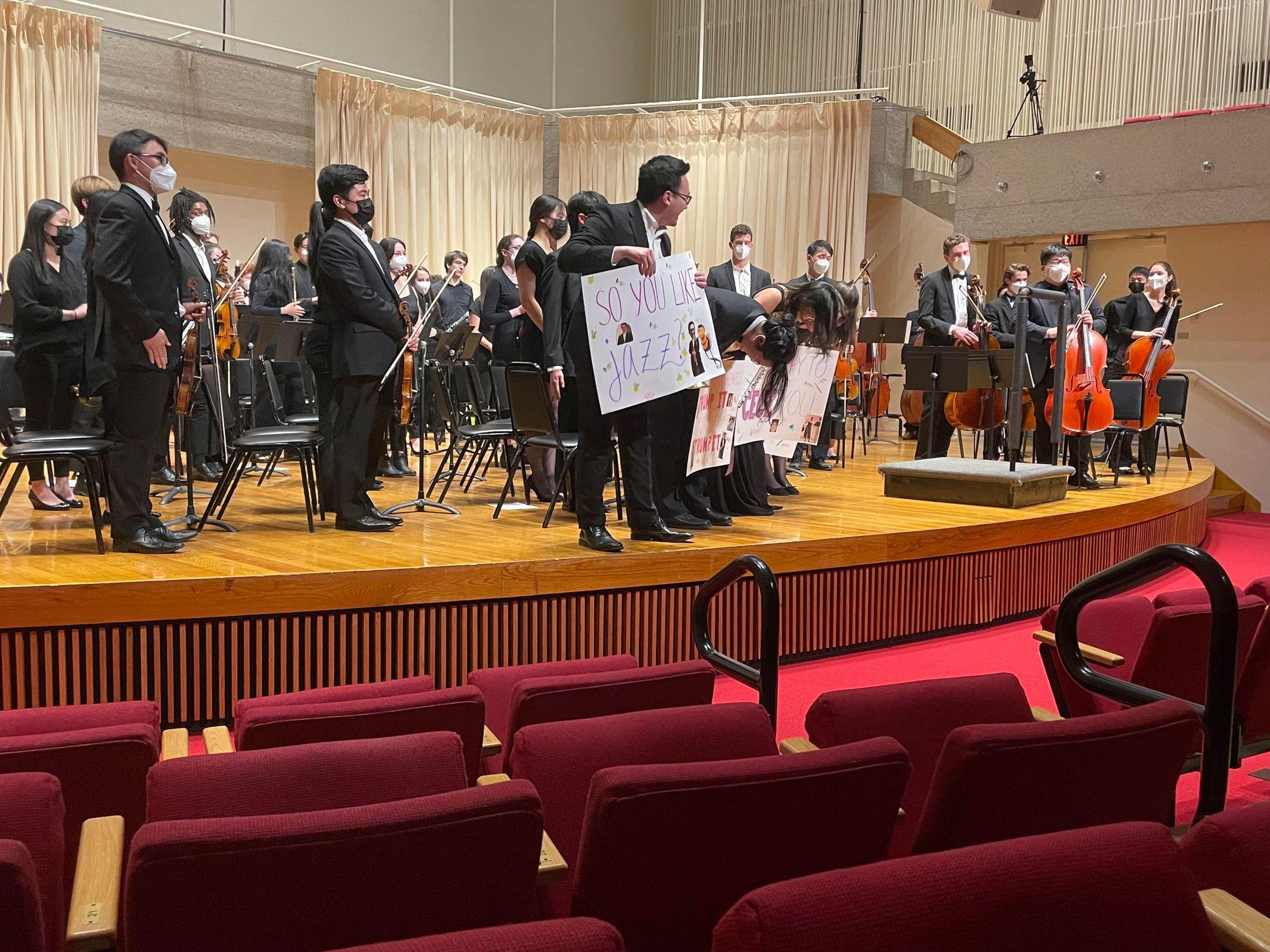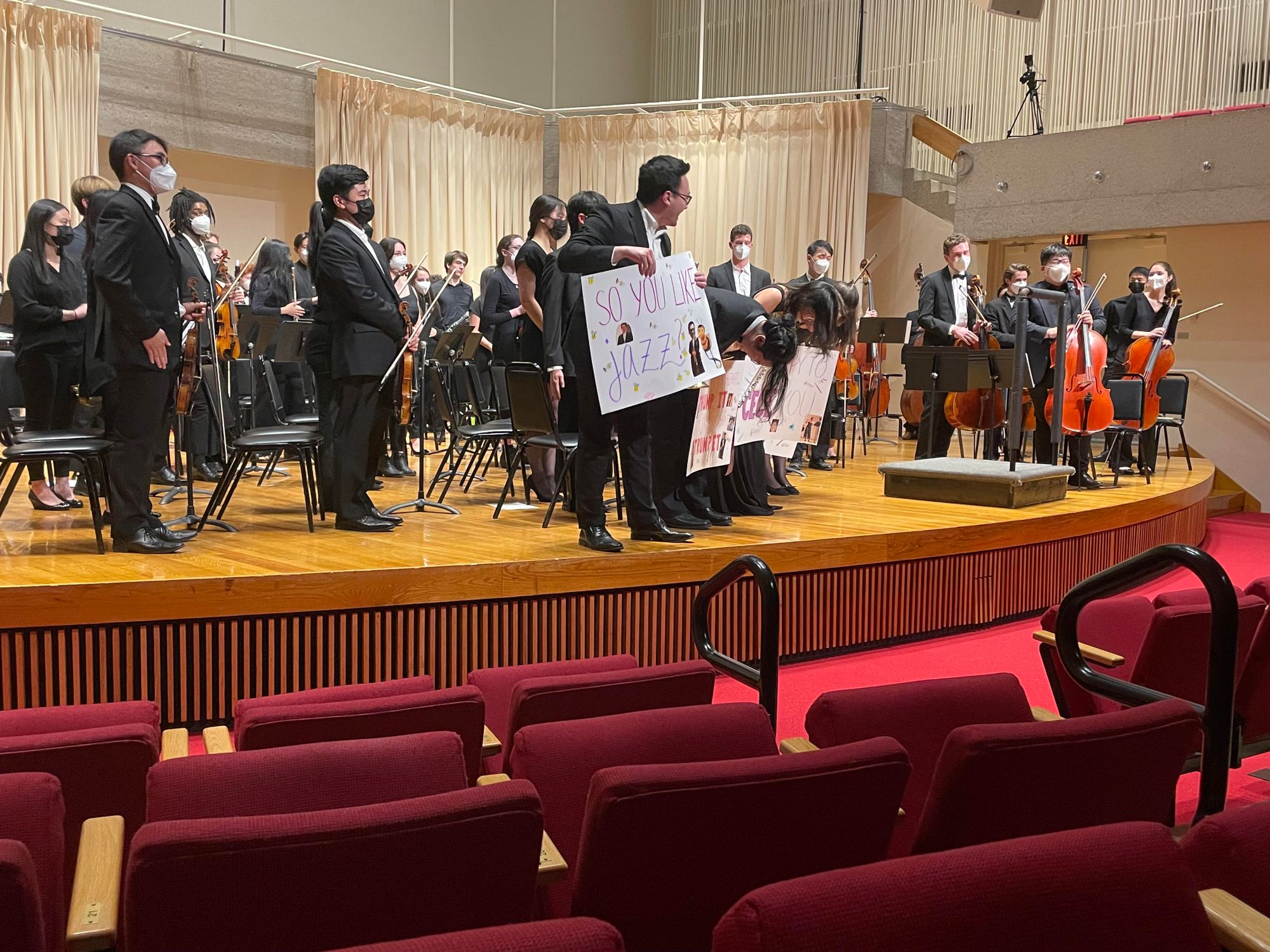Creativity and Craft: ASO’s Compelling Concertos


On April 9, the Amherst Symphony Orchestra (ASO) performed its annual senior showcase in Buckley Recital Hall. Having been delayed from its originally scheduled date of March 5 due to a rise in Covid cases, the performance was the group’s first concert of the semester.
The concert — which featured solo performances from Majd Rouhana ’22, Hannah Goldberg ’22, Cece Hong ’22, Shuzo Katayama ’22, and Cameron Chandler ’20 — was about “the power of an individual to make their own statement,” said Music Director and Conductor Mark Lane Swanson, in addition to artistically expressing solidarity with Ukraine.
The feeling in the room was one of celebration and excitement, as the concert opened with Beethoven’s Symphony No. 9, a dynamic piece with four movements that highlighted the coordination and patience of the group. The first movement was lively and upbeat, pulsing with a catchy melody. But despite the positive energy of Beethoven’s composition, I was struck by the restraint of the group, who employed careful articulation and purposeful changes in dynamics.
The second movement included a famous motif (sometimes sampled in movies and TV), but while I had indeed heard this melody before, the performance brought out emotions that were unfamiliar: a mournful feeling that resolved to curiosity — playfully. Again, the restraint of the orchestra shone in their unified, deliberate moments, which demostrated a confidence that can only come from frequent practice.
The third movement presented a different sort of technical challenge, alternating between a quick and light waltz-like scherzo and a sustained, wide-sounding interlude. As the tempo changed, the players made sure to bring out the unusual shapes in Beethoven’s composition via cleanly executed arpeggios and attentive cues. The group managed to keep the music moving forward without falling into the trap of acceleration.
The fourth and last movement maintained the motion of the previous section, inserting a grinding, tense feeling of drama. For the first time in the concert, I experienced a feeling I have learned to love as a longtime ASO fan: the unmistakable “prickly air” that comes from a sizable group of performers focusing so intently that their emotions feel tangible. The cleanly performed and impactful piece concluded with applause that lasted minutes, a sign of support and admiration from friends and family of the performers.
The “power of the individual” appears in Beethoven’s Seventh as a political force, historically tied to an artistic protest of Russia’s invasion of Ukraine. Swanson hadn’t intended for this connection, but stumbled upon it as a result of historical research: “I thought, ‘Wait a second. Beethoven’s 7th was premiered at a charity concert to raise money for wounded soldiers who were repelling the Napoleonic invasion.’”
After the intermission, the political nature of the concert took center stage. Despite having been composed in 1864, the next piece’s title rings true in the events of today: “Shche ne vernal Ukrainia” (“Ukraine has not yet perished”), the national anthem of Ukraine. It was a declarative march, played assertively compared to the Beethoven. Swanson grounded the music in the events unfolding in Eastern Europe, today and throughout Ukrainian history: “The story of Ukraine is really the individual standing up for people … It’s part of the Ukrainian spirit.”
The five featured soloists, who Swanson characterized as “the representatives of each individual in the orchestra,” each chose one of the pieces that followed. Each soloist played distinctly, reflecting their personalities and artistic preferences.
Rouhana was the first to take center stage, performing the clarinet solo in Carl Maria von Weber’s “Clarinet Concerto No. 11 in F minor.” Standing out even against the sound of the whole orchestra, he flew through arpeggios with a poised calmness. Even in what seemed like a tough section, his articulation was precise and intentional. Swanson observed that “Majd has a kindness and a lightness, and a generosity of person, as a person. And it was fun to see that sort of sense of generosity come through in that piece.” I see that generosity in the varied quality of Rouhana’s performance, like moving water: some moments like playful splashing, other moments like a pressurized hose.
Conducted by Assistant Director Annierose Klingbeil, Mozart’s “Clarinet Concerto in A Major” featured Goldberg, also on clarinet. Goldberg played with a confident and unwavering tone, expressing a quiet, resilient quality. Swanson agreed: “She’s a ‘deep-feeling’ person … And I think it was really a nice opportunity for her to just make a personal expression … but [the piece] is really deceptively difficult: the notes aren’t that hard, but Mozart’s all about color.” Goldberg made it look easy, too, a testament to her attentive playing.
Carl Reinecke’s “Ballade for flute in D minor” featured Hong on flute. Hong played with a mournful and soulful affect, accentuated by moments of well-practiced, jesting, and jousting melodies. Swanson attributed her achievements to the piece and her skill: “She has a really wide range of expression in her instrument, and this piece was able to really showcase her in that.” I had the impression that Hong was carefully listening as well as playing, contributing to a polished harmony with the rest of the orchestra.
As for the next piece, Swanson noted that it was “a really unusual choice for [Katayama] to choose an opera aria to perform on trumpet with a big orchestration.” Instead of a virtuosic concerto that might have been more outspoken, it was “Marietta’s Lied” from Erich Wolfgang Korngold’s opera, “Die Tote Stadt” (“The Dead City”).
But Swanson did not disapprove of the choice at all: “He chose a song. He’s singing to the community on a trumpet … And also the song is about holding on to happiness, which I find really interesting. So, holding on to happiness, singing to his friends — in a melodic piece, not a ‘show off piece’: that’s the thing.” Katayama’s playing was steady, clear and confident, imparting a reassuring restfulness tinged with longing.
The concert closed with Chandler, a longtime orchestra member and former teaching assistant, and his arrangement of “Stardust” by Hoagy Carmichael. Unexpectedly for the audience, Chandler cued in the orchestra himself, without Swanson conducting or anywhere in sight. To Swanson, it was “unfinished business,” because Chandler had wanted to perform this arrangement at the end of his senior year in 2020 before the pandemic hit. It was a fitting end to the concert: a unified orchestra, pushing their boundaries into jazz, playing confidently and completely even without the guidance of their conductor.
But the orchestra was not the only thing backing up the solo performers. Swanson views the Amherst community as just as critical to “the individual power” of ASO: “You’re playing for your friends, you’re saying something to them personally, and that’s what I love about concerts at Amherst, which is unique: it’s a small community … and [the audience] may not even think they like classical music until they come. But when they hear their friends, they go ‘Oh, that was beautiful.’ [The students] are so supportive, and that’s what I love: support from the stage, support from the audience.”
Finally, I asked Swanson, “How would you ask your musicians to reflect on the concert?” He answered with a feeling of wide gratitude towards the players: “I would ask the musicians to think beyond the tremendous technical and artistic achievement that they've been able to accomplish … and to think about what that piece meant, what the works that you performed meant to you. How do they change your perspective on the world?”